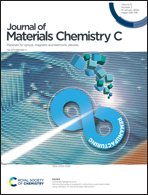Soft nanocomposites of lead bromide perovskite and polyurethane prepared via coordination chemistry for highly flexible, stable, and quaternary metal alloy-printed light emitting diodes†
Abstract
The impressive luminescence properties, tunable bandgap, and cost-effective solution processing of methylammonium lead bromide (MAPbBr3) make it a promising green-light emitter for next-generation displays. However, the commercialization of flexible light-emitting diodes (LEDs) based on MAPbBr3 is hindered by the difficulties of (i) achieving precise morphological control and creating highly flexible pinhole-free MAPbBr3 films, (ii) finding flexible cathode materials with low work functions suitable for effective electron injection at interfaces, and (iii) enhancing environmental and operational stability. To address these challenges, we herein designed solution-processed flexible perovskite LEDs incorporating polyurethane (PU) and an In–Ga–Zn–Sn liquid alloy (IGZS). The PU matrix rendered MAPbBr3 films mechanically flexible and substantially reduced the amount of defects by coordinating Pb2+ ions through amide/carbonyl groups during crystallization. The use of printed IGZS cathodes, which had a lower work function (3.48 eV) than conventional solution-processed cathodes (>4 eV), reduced the energy gap at MAPbBr3-electron injection layer-cathode interfaces and thus favored electron injection. The best-performing MAPbBr3-PU device achieved a maximum luminance (2362.3 Cd m−2), current efficiency (8.79 Cd A−1), and external quantum efficiency (1.93%) more than four times those of the pristine MAPbBr3 device and exhibited high flexibility and durability, retaining over 87% of the above values after 1000 bending cycles at a radius of 7 mm. Moreover, the hydrophobic PU matrix effectively suppressed the infiltration of moisture and thus allowed for the excellent retention of normalized electroluminescence intensity (84.2% after 30 min) during the device operation.



 Please wait while we load your content...
Please wait while we load your content...